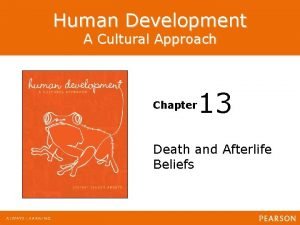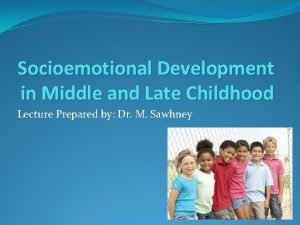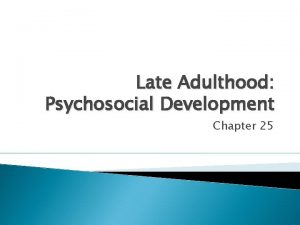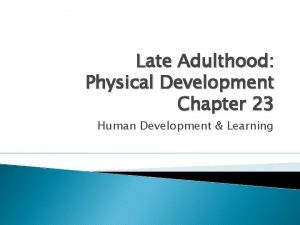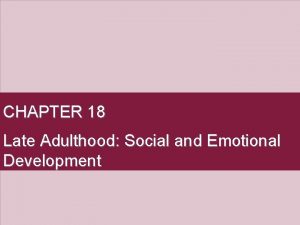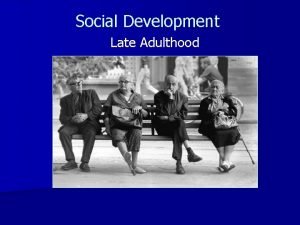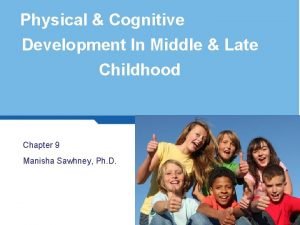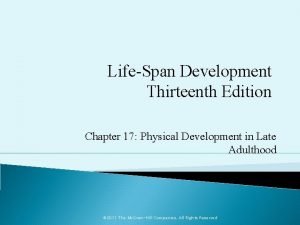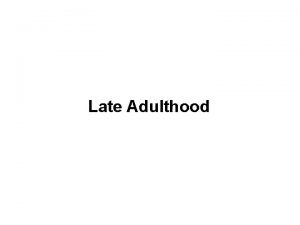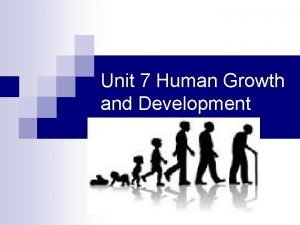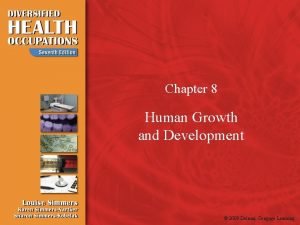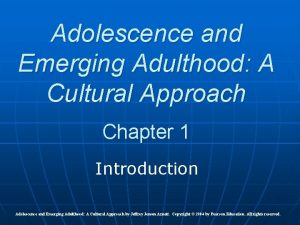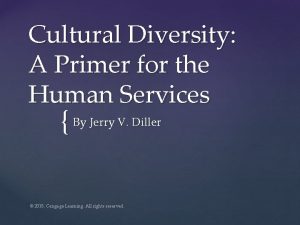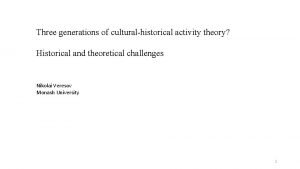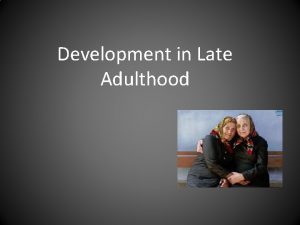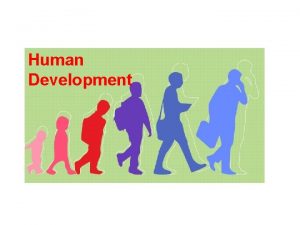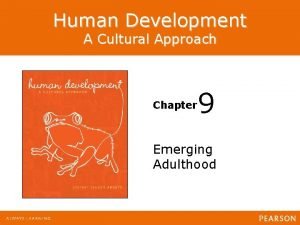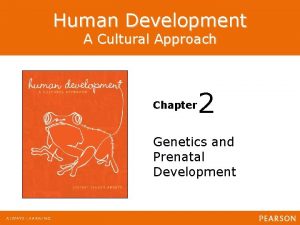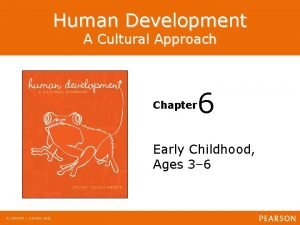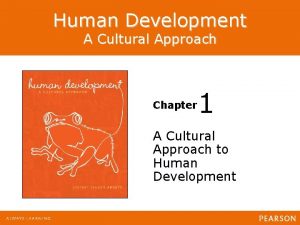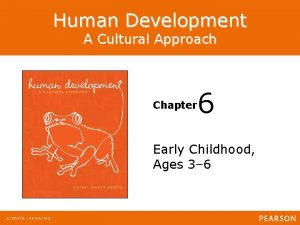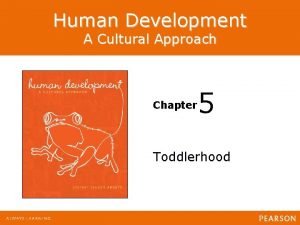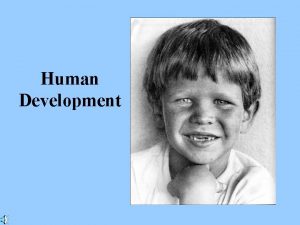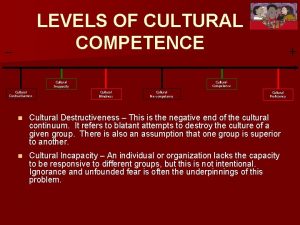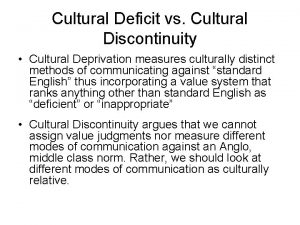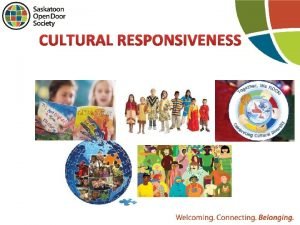Human Development A Cultural Approach Chapter 12 Late














































- Slides: 46

Human Development A Cultural Approach Chapter 12 Late Adulthood Human Development: A Cultural Approach Jeffrey Jensen Arnett

Physical Development Human Development: A Cultural Approach Jeffrey Jensen Arnett

Cultural Beliefs about Late Adulthood • Perception of late adulthood § Asian, African, and Latin cultures have favorable view § Western culture views becoming favorable - Still combat some ageism Human Development: A Cultural Approach Jeffrey Jensen Arnett

Cultural Beliefs about Late Adulthood • Substages of late adulthood § Young-Old— 65 -74 § Old-Old— 75 -84 § Oldest-Old— 85 and up Human Development: A Cultural Approach Jeffrey Jensen Arnett

Cultural Beliefs about Late Adulthood • Perception of late adulthood • Each substage is different regarding physical, cognitive, and social functioning Human Development: A Cultural Approach Jeffrey Jensen Arnett

Cultural Beliefs about Late Adulthood • Differ in performing activities of daily living (ADL’s) and reported health § 1/3 of people over 80 say health is good § Less than ½ of 85 -89 year olds have a disability • Functional age may be better concept to use than chronological age Human Development: A Cultural Approach Jeffrey Jensen Arnett

Global Aging Pattern • Old-Age Dependency Ratio (OADR) § Number of persons aged 65 or older Number of persons aged 20 -64 • Bottom number represent work force who pay into government Human Development: A Cultural Approach Jeffrey Jensen Arnett

Global Aging Pattern • Top number represents those not in workforce but receive government benefits • OADR increase means more people receiving benefits and not enough paying in to cover Human Development: A Cultural Approach Jeffrey Jensen Arnett

Global Aging Pattern • Reasons for climbing OADR § Birth rate peaked (represent workforce) § Medical care increases longevity • Some gender differences in life expectancy Human Development: A Cultural Approach Jeffrey Jensen Arnett

Physical Changes • Hair continues to gray and thin • Bones thin especially in women • Age spots develop—sun exposure hastens development • Height and weight decline • Teeth yellow • Exercise and healthy diet can slow some appearance changes Human Development: A Cultural Approach Jeffrey Jensen Arnett

Changes in Senses • Vision § Reduced visual acuity § Cataracts - Most common visual impairment § Increased chance of Macular Degeneration § Increased chance of Glaucoma Human Development: A Cultural Approach Jeffrey Jensen Arnett

Changes in Senses Human Development: A Cultural Approach Jeffrey Jensen Arnett

Changes in Senses • Hearing § Acuity diminishes for high-pitched sounds § May develop tinnitus § Can lead to social isolation • Taste and smell § Decline in taste and smell can make food less enjoyable § Dangerous smells not detected Human Development: A Cultural Approach Jeffrey Jensen Arnett

Physical Changes in Sleep • Quality of sleep declines with age § Sleep less deeply § Time in light sleep increases • Sleep Apnea common sleep problem § Can be treated with CPAP device • Psychological issues can also impair sleep § Depression, anxiety, and medical conditions Human Development: A Cultural Approach Jeffrey Jensen Arnett

Health in Late Adulthood Chronic Health Problems • Common health issues are: arthritis osteoporosis, and hypertension • Arthritis—disease of the joints § Cartilage that cushions joints wear out § Women affected more than men - Management involves medication, inserting new joints and/or exercise Human Development: A Cultural Approach Jeffrey Jensen Arnett

Health in Late Adulthood Chronic Health Problems • Osteoporosis § Increased risk for broken bones § Exercise and calcium-rich diet for treatment • Hypertension § Secondary aging makes condition worsen § Diet and medications are treatment options Human Development: A Cultural Approach Jeffrey Jensen Arnett

Health in Late Adulthood Health Care and Health Promotion • Medical intervention can combat health problems • Developed countries allow access to healthcare • Rising OADR will cause future financial strain • Healthy lifestyle can help Human Development: A Cultural Approach Jeffrey Jensen Arnett

Figure 12. 3 Use of Medical Resources by Age Group Persons age 65 and over consume far more medical resources than persons in other age groups. Source: OECD (2009) Human Development: A Cultural Approach Jeffrey Jensen Arnett

Health in Late Adulthood Health Care and Health Promotion • Healthy lifestyle includes: § Healthy diet—low fat and sugar, taking multivitamins § Regular exercise—lowers risk of disease, increases muscle and bone mass - Aerobic and strength training beneficial § Avoid smoking and alcohol Human Development: A Cultural Approach Jeffrey Jensen Arnett

Cognitive Development Human Development: A Cultural Approach Jeffrey Jensen Arnett

Cognitive Changes and Decline Changes in Attention and Memory • Declines in § Selective Attention § Divided Attention § Sustained Attention • Memory effects include § Working memory decline § Episodic and autobiographical memory decline § Source memory decline Human Development: A Cultural Approach Jeffrey Jensen Arnett

Cognitive Changes and Decline Dementia and Alzheimer’s Disease • Biological brain changes include § Brain mass decline § Spaces within brain increase - Hippocampus, cerebellum, frontal lobes § Neurotransmitters decline - Acetylcholine and dopamine Human Development: A Cultural Approach Jeffrey Jensen Arnett

Cognitive Changes and Decline Dementia and Alzheimer’s Disease • Aging increases risk of dementia § Alzheimer’s disease most common - Loss of memory for recent events including people - increased anxiety and aggression § Two features include - Accumulation of plaques - Neurofibrillary tangles Human Development: A Cultural Approach Jeffrey Jensen Arnett

Cognitive Changes and Decline Dementia and Alzheimer’s Disease • Risk factors include § Gene - Apo. E gene or all onset but may not determine developing Alzheimer’s § Diet • Protective factors include § Cognitive activity § Physical exercise § Diet Human Development: A Cultural Approach Jeffrey Jensen Arnett

Alternative Views on Cognitive Changes Wisdom • Wisdom—expertise in the conduct and meaning of life § Includes insight, knowledge, strategies, values, and awareness • Current research § No clear link to age and being wise § Future research may examine cultural differences § Impact of culture’s rates of social change Human Development: A Cultural Approach Jeffrey Jensen Arnett

Alternative Views on Cognitive Changes Dealing with Cognitive Decline • Late-life learning § Regular mental exercise slows cognitive decline • Selective Optimization with Compensation (SOC) § Selecting valued activities § Optimize performances in those activities § Compensating for decline by using new strategies Human Development: A Cultural Approach Jeffrey Jensen Arnett

Alternative Views on Cognitive Changes Dealing with Cognitive Decline Human Development: A Cultural Approach Jeffrey Jensen Arnett

Emotional and Social Development Human Development: A Cultural Approach Jeffrey Jensen Arnett

Figure 12. 4 Age and Emotional States In the course of late adulthood, positive affect rises steadily. Source: Mroczek (2001) Human Development: A Cultural Approach Jeffrey Jensen Arnett

Emotional and Self-Development Theories on Emotions in Late Adulthood • Erikson’s—Ego integrity vs. despair § Ego integrity—looking back on one’s life and accepting outcome § Despair—regrets and bitterness about the course of one’s life • Physical and cognitive problems can impact self-esteem and integrity § Depression can increase risk of despair Human Development: A Cultural Approach Jeffrey Jensen Arnett

Emotional and Self-Development Theories on Emotions in Late Adulthood • Socioemotional Selectivity Theory— maximize emotional well-being by becoming increasingly selective with social contacts § Goals change - Knowledge based - Emotion based • Older adults seek relationships low in conflict and high in mutual enjoyment Human Development: A Cultural Approach Jeffrey Jensen Arnett

The Sociocultural Contexts of Development Family Relationships • Contact with adult children continue into late adulthood • Asian cultures believe in Filial Piety § Obligation to parents and provide care with age § Assistance flows from children to parents Human Development: A Cultural Approach Jeffrey Jensen Arnett

The Sociocultural Contexts of Development Family Relationships • Western cultures § Assistance flows from parents to children • Gender differences § Daughters provide more care § Sons financial Human Development: A Cultural Approach Jeffrey Jensen Arnett

The Sociocultural Contexts of Development Family Relationships • Relationships with grandchildren are positive § Closeness and affection remain strong § Gender differences - Closer to grandmother than grandfather § Great grandchildren signal family endurance Human Development: A Cultural Approach Jeffrey Jensen Arnett

The Sociocultural Contexts of Development Living Arrangements in Late Adulthood • Western countries § Living independently - Northern Europe—Independent - Southern Europe—Live with child § Living facilities - Assisted living and nursing homes - Personal control important • Asian countries § Living independently or with adult child Human Development: A Cultural Approach Jeffrey Jensen Arnett

The Sociocultural Contexts of Development Love and Sexuality • Marital satisfaction at peak § Divorce would have occurred earlier leaving strongest marriages § Fewer daily responsibilities that cause stress § More time to enjoy leisure activities § Solve disagreements calmly Human Development: A Cultural Approach Jeffrey Jensen Arnett

The Sociocultural Contexts of Development Love and Sexuality • Depression and loneliness follows losing a spouse • Widows more common than widowers • Social contact important for recovery Human Development: A Cultural Approach Jeffrey Jensen Arnett

The Sociocultural Contexts of Development Love and Sexuality • Sexual behavior expectations differ by culture • Activity relies on partner availability and physical health • With assistance some problems correctable § Women—lubrication, Men—medication for erectile dysfunction Human Development: A Cultural Approach Jeffrey Jensen Arnett

The Sociocultural Contexts of Development Love and Sexuality • Intimate acts more common than sexual intercourse • Masturbation remains common Human Development: A Cultural Approach Jeffrey Jensen Arnett

Figure 12. 6 Sexuality in Middle and Late Adulthood In American society, many adults age 45 and over take part in a variety of sexual activities. This figure shows the percentage of adults engaging in sexual activities once a week or more often within the past six months. Source: Based on AARP (2009) Human Development: A Cultural Approach Jeffrey Jensen Arnett

The Sociocultural Contexts of Development Work and Retirement • Median retirement age is 60– 63 • Longer life expectancies increase retirement age • Retiring impacted by § Finances, physical health, and job satisfaction Human Development: A Cultural Approach Jeffrey Jensen Arnett

The Sociocultural Contexts of Development Work and Retirement • Satisfaction highest if retirement by choice • May retire gradually but not for money § Social contact and remaining active • May have problems in obtaining work Human Development: A Cultural Approach Jeffrey Jensen Arnett

The Sociocultural Contexts of Development Life Outside of Work and Home • Time devoted to leisure activities, community activities, and religious involvement • Leisure activities § Increased time to continue previous interests § Increased travel if able § Time spent doing non-demanding activities Human Development: A Cultural Approach Jeffrey Jensen Arnett

The Sociocultural Contexts of Development Life Outside of Work and Home • Community service and civic engagement • Enhance well being of future generations • Efforts increase social well-being • Enhance seniors well-being Human Development: A Cultural Approach Jeffrey Jensen Arnett

The Sociocultural Contexts of Development Life Outside of Work and Home • Religious involvement § Participation increases § Practices and beliefs increase § Women more religious than men but men hold dominate positions § Promotes self esteem, life satisfaction, and overall happiness § Promotes better physical health Human Development: A Cultural Approach Jeffrey Jensen Arnett

The Sociocultural Contexts of Development Life Outside of Work and Home • Television, movies, reading, music compose 40% of leisure time • Television use increases throughout life • Impacts globalization • Internet use lowest in later adulthood § Can have positive outcomes if taught to use internet Human Development: A Cultural Approach Jeffrey Jensen Arnett
 Human development a cultural approach
Human development a cultural approach Cna chapter 8 human needs and human development
Cna chapter 8 human needs and human development Chapter 8 human needs and human development
Chapter 8 human needs and human development Gni definition ap human geography
Gni definition ap human geography Middle and late childhood symbol
Middle and late childhood symbol Physical development of late childhood
Physical development of late childhood Psychosocial development in late adulthood
Psychosocial development in late adulthood Later adulthood physical development
Later adulthood physical development Late adulthood cognitive development
Late adulthood cognitive development Adulthood social development
Adulthood social development Robert peck developmental tasks
Robert peck developmental tasks Socioemotional development in late adulthood
Socioemotional development in late adulthood Disengagement theory
Disengagement theory Late development vs autism
Late development vs autism Physical development in late adulthood
Physical development in late adulthood Late adulthood physical development
Late adulthood physical development Stages of growth and development from infancy to adulthood
Stages of growth and development from infancy to adulthood Human growth and development
Human growth and development Chapter 8:1 life stages
Chapter 8:1 life stages The cultural approach
The cultural approach A cultural approach to understanding mass communication
A cultural approach to understanding mass communication A cultural approach to media recognizes
A cultural approach to media recognizes Whole school approach to cultural diversity
Whole school approach to cultural diversity Jeffrey arnett emerging adulthood theory
Jeffrey arnett emerging adulthood theory Chapter 5 diversity and human needs and development
Chapter 5 diversity and human needs and development Chapter 36 section 1 reproductive systems
Chapter 36 section 1 reproductive systems Infancy psychosocial development
Infancy psychosocial development Lesson 4 the late middle ages
Lesson 4 the late middle ages Example of virtual circuit network
Example of virtual circuit network Theoretical models of counseling
Theoretical models of counseling Fine-grained screening
Fine-grained screening Approach approach conflict
Approach approach conflict Cognitive approach vs behavioral approach
Cognitive approach vs behavioral approach What is research approach definition
What is research approach definition Approach to system development
Approach to system development Tony wagner's seven survival skills
Tony wagner's seven survival skills Perceptual region definition
Perceptual region definition Sustainability definition ap human geography
Sustainability definition ap human geography Fred kniffen housing styles
Fred kniffen housing styles Migrant diffusion
Migrant diffusion Cultural divergence definition geography
Cultural divergence definition geography Cultural diversity a primer for the human services
Cultural diversity a primer for the human services Cultural cohesion ap human geography
Cultural cohesion ap human geography Cultural homogenization ap human geography
Cultural homogenization ap human geography Cultural relativism ap human geography
Cultural relativism ap human geography Cultural development theory
Cultural development theory Intangible cultural heritage and sustainable development
Intangible cultural heritage and sustainable development
